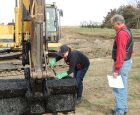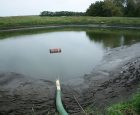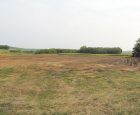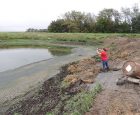
Equipment
Equipment
Storage
Decommissioning earthen storage
While closing its swine manure storage lagoon, the University of Nebraska extension team documented the process and created a roadmap to help producers who may be taking on a similar task.
June 6, 2019 by Diane Mettler
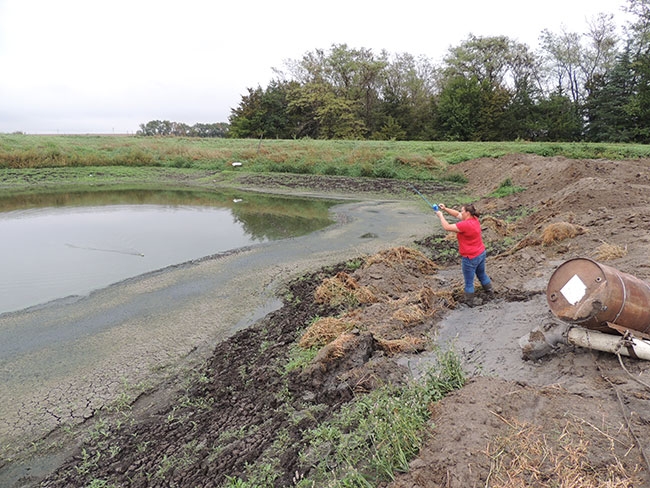 Leslie Johnson casting out a fishing rod to determine an estimated sludge depth in the lagoon. All photos courtesy of Leslie Johnson, University of Nebraska.
Leslie Johnson casting out a fishing rod to determine an estimated sludge depth in the lagoon. All photos courtesy of Leslie Johnson, University of Nebraska.In 2016, the University of Nebraska decided to close down their swine manure storage lagoon. The hog facility at the university had not been in operation for nearly a decade, and since the lagoon was no longer being used, it was an environmental responsibility.
“We felt [decommissioning] it would be a golden opportunity to chart and document the process and create a learning tool for any farmer planning to decommission their earthen manure storage, whether dairy, beef or swine,” says Leslie Johnson, animal manure management coordinator for the University of Nebraska.
Planning
Like with any major project, the first step is planning. Removing the contents and filling in the lagoon must be handled properly to protect the ground and surface waters.
“To minimize environmental risk, and to meet any state and local regulatory requirements, it’s recommended that a farmer consult the regulatory agencies in the state prior to initiating a closure to identify any state-specific requirements,” says Amy Millmier-Schmidt, livestock bioenvironmental engineer with the university.
The University of Nebraska team identified two stages to closing a lagoon. The first stage is to use the nutrients stored in the sludge and maximize their agronomic value while ensuring minimal risk to the environment. The second stage is to either bury the structure or convert it into a pond.
Determining sludge volume
Stage one requires determining exactly how much sludge is in the lagoon, its nutrient content and the nutrient needs of the land where the sludge will be used as fertilizer. By doing this, the farmer can balance the amount of sludge distributed on the land and reduce any off-site environmental impacts.
In order to determine how much sludge is in the lagoon and how much land it will be able to fertilize, requires an analysis of both the nutrients and the volume of sludge in storage. To estimate the sludge volume, the farmer must know the full depth of the lagoon, which can be found in the design plan, the nutrient management plan, or on the permit, along with stage storage levels.
The more difficult part of this task is determining the depth of liquid. The most cost effective and simple method for measuring the lagoon storage’s liquid volume is to use a fishing rod with a bobber and a lead weight says Johnson. Put the lead weight at the bottom of the fishing line, and attach a bobber, at the “gestimated” depth. Cast the line out over the pond, and when the liquid depth is exactly the same as the weight, the bobber will tip on its side. If the weight is not on the bottom of the pond, the bobber stays upright.
Measure the distance from the bobber to the weight. That will be the liquid depth at that particular point in the pond. Because the liquid depth will not be same across the pond, several measurements are necessary in various areas. Next, subtract that average volume measurement from the full volume of the full depth of the pond. The result will be the volume of the sludge.
A more accurate method to determine the volume of sludge is to use a boat with a sonar system, similar to a fish finder. However, this equipment is expensive, requires calibrating, and safety precautions are necessary for the persons in the boat, but the results are extremely accurate.
Determining nutrient value
The most accurate method to obtain the nutrient value of the sludge is to take samples and have them analyzed at a laboratory. If the plan is to agitate the lagoon or storage basin prior to removing the liquid and sludge, a sample can be collected then, but should be taken again after several hours or even days of agitation to ensure a well-mixed and representative sample.
If the effluent is to be pumped, and the sludge removed separately, the liquid and sludge will need to be sampled independently. Since few methods exist for collecting the sludge while it is still in the storage structure, it must be collected as it is removed. Millmier-Schmidt adds that multiple samples should be collected and combined to create a composite sample for submission to the laboratory.
“While initial land application activities may be conducted without the nutrient analysis completed, lab results are usually available within a few days, and application rate adjustments can then be made for the remaining volume of sludge,” Millmier-Schmidt says.
Once samples have been collected, it is best to submit them to the laboratory as soon as possible to receive the most accurate results. Fresh or frozen samples will provide the same results. With the test results, calculations can be made to determine the amount of sludge required for the acreage of land and the nutrient concentrations needed. These calculations can be found by contacting the University of Nebraska, or, in other states, agronomists and various agencies.
Sludge removal
The two most common methods for sludge and effluent removal from a lagoon are either to dewater the lagoon and then remove the sludge, or agitate the lagoon and remove the slurry all at once. The first option requires access to irrigation or drag-hose systems, and then handling much larger volumes of sludge. The alternative method of agitation allows for the combined slurry to be pumped and applied to cropland through a drag hose system or tank-style spreader. Inevitably there will still be sludge remaining, but the volume will be much less than the dewatering method.
“Remember, our pond had been inactive for close to a decade,” Johnson says. “Because it had been sitting there so long, we didn’t have a lot of water so we used the dewater method and hauled the sludge separately. I would never recommend anybody doing it that way if they can help it. It is a lot more work.”
Sludge removal in either method requires an excavator (or large loader), and a manure spreader, which can handle liquid or slurry manure. Side-slinger style spreaders are likely to handle manure of this consistency the best.
Spreading calculations
One of the simplest ways to calculate how much to spread is to place several 22 square-foot sheets of plastic across the field, using rocks or flags to hold the sheets in place. Fertilize the field as usual and collect each sheet individually. Weighing each sheet individually in a bucket, subtract the weight of the bucket containing a clean plastic sheet from the weight of the bucket with the manured sheet. And, because the sheet is 22-square-feet, the application rate in tons-per-acre is equal to the weight of manure on the sheet.
“Once we started hauling, I would say the whole process took about two months because we were fitting it around other projects,” Johnson says. “But if you were on an active operation, and/or you were selling that manure and had everything in place, I would say it would not take that long at all.”
Filling in the lagoon
Some states require the regulatory agency to inspect the structure once it is empty. So, once the storage has been emptied, contact the state regulatory agency to determine if land grading and deconstruction of the berm can progress. For structures that were built with a compacted clay liner, it can either be excavated and tilled in with the surrounding soil or left intact and covered with soil. If left largely intact, holes or trenches in the liner are recommended to allow storm water to effectively drain from the area. A liner left intact below the surface of the soil may lead to frequent ponding or permanently wet soil at the location.
“The leveling of the berms is much easier than hauling the manure out and is really easy if you have the equipment,” Johnson says. “When the berms have been deconstructed and clay liner incorporated into surrounding soil, the area is mounded slightly to facilitate drainage and accommodate settling of the soil over time.”
Establishing and maintaining permanent vegetation cover is the final step of decommissioning the storage area and prevents erosion. The National Resource Conservation Services offers a conservation practice standard (code 327) that describes criteria for establishing conservation cover. At a minimum, it is important to select plant species that are best suited to the soil, climate and site conditions.
